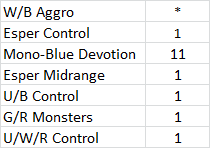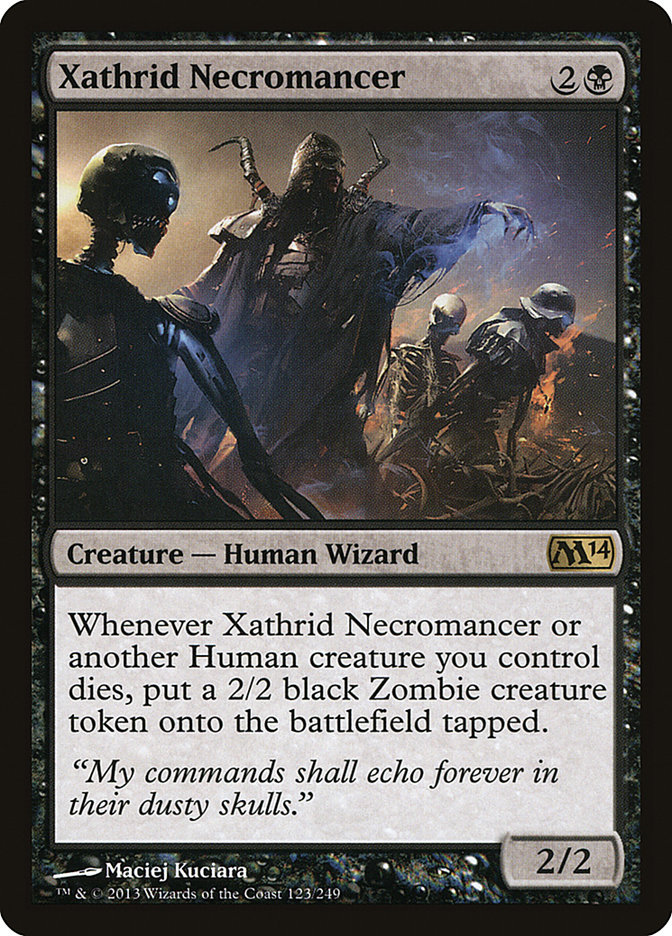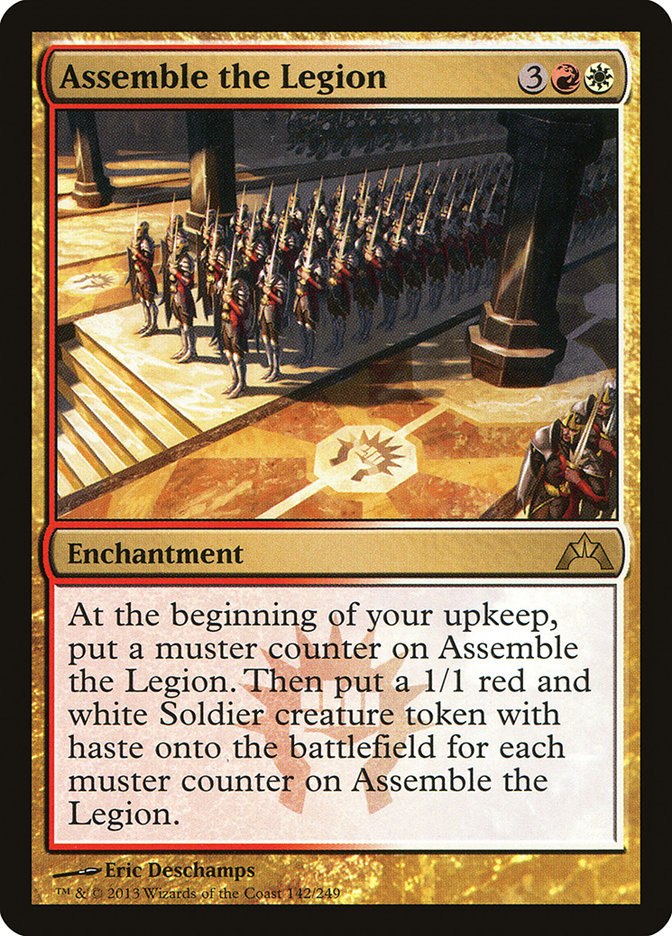Don’t nap on the end-of-year Standard Grand Prix.
You know the one. December, maybe January. Christmas or thereabouts.
You can get it in your head that a format is solved or that we are waiting on the next set to change up the metagame or just waiting for next year. But the past couple of years Standard Grand Prix in the last weeks (or first!) of the year have often showcased amazing firepower capable of turning a format on its ear or at least challenging the status quo.
Mono-Blue Devotion?
Mono-Black Devotion?
Don’t nap on that end-of-year Standard Grand Prix.
Remember this gem?
Creatures (18)
- 4 Huntmaster of the Fells
- 4 Nightshade Peddler
- 1 Zealous Conscripts
- 4 Angel of Glory's Rise
- 1 Goldnight Commander
- 4 Izzet Staticaster
Lands (23)
Spells (19)

A year ago the pieces of the Standard format were largely in place. Even though seating arrangements for Innistrad and Return to Ravnica blocks would shuffle about a bit still, we already knew about Thragtusk, Restoration Angel, Thundermaw Hellkite, Bonfire of the Damned, and a general list of usual suspects as long as your arm. We certainly knew what Unburial Rites could do (the great Kenji Tsumura himself shared Okita’s Top 8 with the archetype Junk Reanimator deck) . . . Or did we?
Okita closed out December 2012 with quite a surprising look at Unburial Rites.
Using Chronic Flooding to set up his library— err, graveyard—Okita flipped the script on Unburial Rites in Standard. Instead of go-to life-gain token-tagalong creature Thragtusk, he chose Human life-gain token-toter Huntmaster of the Fells (most Reanimator decks didn’t even play red). And instead of Angel of Serenity . . . Angel of Glory’s Rise!
Okita’s deck was great at dumping Humans into the graveyard. So when Angel of Glory’s Rise inevitably came into play (often from an Unburial Rites that had been set up with the same Chronic Flooding that stacked and stockpiled the rest of the deck), it would come back with all manner of Human threats.
Izzet Staticaster and Nightshade Peddler were a pocket combo, whether they came out of the graveyard or just played the two- and three-mana positions. They were great at locking down a board and defending life points.
But with the one Goldnight Commander . . .
The haste of Izzet Staticaster could have a very different effect on the game!
Given enough creatures hitting the battlefield in a turn (you know, the way Angel of Glory’s Rise might bring back all the Humans), Goldnight Commander could combine with the haste of Izzet Staticaster and Zealous Conscripts to just kill the opponent all in one turn! The deck was powerful from many directions. Chronic Flooding was both great at what it was supposed to do and unexpected. Izzet Staticaster and Nightshade Peddler had the Human thing going with Angel of Glory’s Rise but had their own thing going as well. One-turn kill was an option. Unburial Rites and Huntmaster of the Fells both punch above weight. Angel of Glory’s Rise itself? Potentially enormous in terms of its offensive impact, but also possessed of a number of additional advantages. You could hard cast it to dodge Ground Seal; B/R Zombies was a dominant deck of the era. So many angles and options.
Okita’s December deck spiked a Grand Prix. It was never really heard from again but managed to be influential in terms of future decks like Peddle to the Metal and at least two further looks at Humans / infinite Reanimator decks.
Point being if you thought Standard was solved before Okita and his Angel of Glory’s Rise, you probably would have gotten mugged at his Grand Prix.
Creatures (16)
Lands (21)
Spells (23)

This is fudging a bit because the PV’s Grand Prix was actually in January, but it still managed to start shifting the old paradigm before the next set hit.
Delver of Secrets was not yet the centerpiece.
It had started to see play, but the world still collectively thought of the blue-based beatdown deck in Standard as “Illusions.” Just check out Adam Prosak’s deck from the immediately preceding Invitational:
Creatures (18)
Lands (20)
Spells (22)

Or Stephen Mann’s deck from the same Grand Prix Top 8:
Creatures (21)
- 4 Phantasmal Bear
- 4 Lord of the Unreal
- 4 Phantasmal Image
- 4 Snapcaster Mage
- 1 Geist of Saint Traft
- 4 Delver of Secrets
Lands (20)
Spells (19)
Sideboard

Most of these decks started with Phantasmal Bear and curved into Lord of Illusions!
PV’s deck though was inches from the archetype Delver deck that would make Matt Costa’s reputation and essentially define Standard until the release of Return to Ravnica (or at least the disappearance of Ponder and Mana Leak).
The finals of Grand Prix Orlando was a Colorado brew-fest quasi-mirror, with Patrick Chapin and Grixis Control up against Conley Wood with Glissa Ramp; needless to say neither deck was anywhere near the established metagame, only at its top.
I bring all this up because once again we can see that human experience has structure. Mono-Blue and Mono-Black Devotion decks have in large part dominated the conversations around Standard and probably for good reason. These are powerful decks; devotion is a powerful mechanic that is likely to only get better as more cards are printed.
But that doesn’t mean that there isn’t room in the room for other compelling—even potentially dominating—strategies. Last weekend’s Grand Prix Shizuoka gave us a little “more of the same” with a couple of Mono-Blue Devotion decks, a little recognizable Esper Control . . . but most interestingly an Esper Midrange talk-of-the-tournament and a straight Dimir from a former Player of the Year.
The Grand Prix Shizuoka Top 8:

W/B Aggro
Creatures (29)
- 3 Dryad Militant
- 4 Precinct Captain
- 4 Boros Elite
- 4 Daring Skyjek
- 4 Banisher Priest
- 3 Imposing Sovereign
- 3 Xathrid Necromancer
- 4 Soldier of the Pantheon
Lands (22)
Spells (9)
Sideboard

Ryo Nakada took down Grand Prix Shizuoka with the black-tinged White Weenie deck du jour. An Orzhov Guildgate and half a Pithing Needle off of Ben Stark’s Top 8 deck list from Dallas-Fort Worth a few weeks ago, this deck is really not that far off of Ben Lundquist’s W/R from the SCG Standard Open: Los Angeles.
The incentives are clear. Soldier of the Pantheon is maybe the best Savannah Lions of all time. Dryad Militant has some extra text itself. For a Standard deck, these are great first-turn plays.
Boros Elite rounds out the one-drops, threatening a 3/3 attacker rather than a “mere” 2/1 come turn 3.
Follow up with Daring Skyjek? Maybe with a Mutavault? The damage packs on quickly. Brave the Elements has helped to guide creature-heavy White Weenie success stories as storied as Paul Rietzl; it can certainly help out against potential blockers or the ire of the hostile divine here.
The incentives, as we said, are clear. This deck has some potential battalion buffing. Boros Elite into Mutavault + Daring Skyjek is just one line. There is individual power here too. There isn’t much better on the first turn than Soldier of the Pantheon, and Precinct Captain is constantly threatening to take over games all by itself (by the way, it is also a one-card battalion enabler).
Orzhov Charm makes for some flexibility; it is both an efficient removal spell and a one-drop re-buy machine. Spear of Heliod makes for some staying power and a drop of defense.
Banisher Priest is very quietly a Rakdos Keyrune if you take my meaning. It’s not the card anyone points to, but it can really gum up the works. So-called “indestructible” creatures like Thassa, God of the Sea seem awfully destructible when Banisher Priest is on the battlefield. Big guys like Desecration Demon simply stop holding the line. Just a great tempo swinger that can also attack.
The only straight black card in the W/B Aggro maindeck is bordering on “something special” in this metagame. A Human among many white Humans, this card gives W/B Aggro some much-needed Supreme Verdict defense or just the opportunity to win combats (or at least make the opponent scratch their head). More on this conditional powerhouse a bit later.
Three-Color Control Decks
Grand Prix Shizuoka put some twists and turns even on the seemingly recognizable multicolor control decks. Esper . . . sure. But U/W/R as well!
Creatures (2)
Planeswalkers (6)
Lands (27)
Spells (25)
- 4 Last Breath
- 2 Syncopate
- 2 Essence Scatter
- 2 Azorius Charm
- 4 Supreme Verdict
- 4 Detention Sphere
- 4 Sphinx's Revelation
- 3 Dissolve
Sideboard

I had to double-take and then triple-take on this list.
First I had it mislabeled in my notes as Esper, thrown off by scanning the word “Temple.” Then I realized my mistake and thought I was looking at a U/W deck that wanted to borrow some extra Scry 1 (totally understandable) . . . and then I realized this deck is packing.
Maindeck this is a much more offensively capable deck than we have seen recently from the likes of Andrew Cuneo or Huey Jensen. Rather than the (so-called?) (onetime?) Standard control trump card Elixir of Immortality, Tsukagoshi’s “U/W” just plays a ton of finishers. Six planeswalkers and two Aetherlings! And all four Mutavaults!
Obviously if a game goes many, many turns, something is going to resolve. Standard Control decks just don’t play enough permission for that not to be the case. Of the big things that can potentially resolve, Aetherling is great at defending itself and basically the pace car for Standard inevitability. Aetherling does many things well; not everything, mind you, but many things . . . And what it does the best is close out games in which it is relevant. Aetherling is tough to kill but hits very hard. Whereas attempting to win a game with Jace, Architect of Thought might take a lot of thought and even more time, Aetherling takes about three turns and relatively little thought.
The defining characteristic of this style of control deck might be implied offense . . . if not for those eight red-producing lands.
There aren’t many red cards in this 75, but this five-drop enchantment certainly warrants a mention. Anyone who has played Mono-Black Devotion knows to at least respect Assemble the Legion; most decks packing it can’t prevent a planned multiple Gray Merchant of Asphodel comeback with Essence Scatters and Dissolves though.
Archangel of Thune, Fiendslayer Paladin, and Blind Obedience combine for a kind of semi-transformation. Life gain in general can be quite relevant, and hard-to-stop / recurring / “card advantage” life gain like we see here can be a problem for burn decks. Not surprisingly, these are just more ways to win in a control deck chock full of ways to win.
Of the three, Blind Obedience may be the most important. Decks like this are flat-out bad against Obzedat, Ghost Council (especially when combined with Whip of Erebos). Blind Obedience takes a little of the starch out of Obzedat. But they are also potentially soft to Chandra’s Phoenix and Stormbreath Dragon, especially in creature-poor (but not creature-less) decks. Those kinds of decks can be difficult to sideboard against. Your creature removal is not dead, but it often feels bad . . . But you don’t want to pull your armor completely off either. Argh! Been there? It can be tough to sideboard against these decks.
Blind Obedience can at least take the haste out of the opponent’s offense; obviously you can just win with it as well.
Creatures (1)
Planeswalkers (5)
Lands (27)
Spells (27)
- 2 Last Breath
- 2 Syncopate
- 2 Thoughtseize
- 4 Supreme Verdict
- 4 Detention Sphere
- 4 Sphinx's Revelation
- 1 Dimir Charm
- 3 Devour Flesh
- 1 Warped Physique
- 2 Hero's Downfall
- 2 Dissolve
Sideboard

We’ve looked at lots of Esper Control decks since before Pro Tour Theros. Most recently, Last Breath has emerged as a relevant tool despite being surrounded by seemingly more flexible black removal.
I just wanted to highlight some further exploration by former World Champion Iyanaga: Dimir Charm and Warped Physique.
Iyanaga is just spidering out some options here . . . one copy of each main deck alongside two Last Breaths. These are not the numbers of confidence or certainty, but they all kill a Nightveil Specter and answer most early-game threats. The BU options also retain some value later in the game.
Esper Midrange
Creatures (24)
- 4 Lyev Skyknight
- 3 Desecration Demon
- 3 Obzedat, Ghost Council
- 3 Daring Skyjek
- 1 Cartel Aristocrat
- 2 Imposing Sovereign
- 4 Xathrid Necromancer
- 4 Soldier of the Pantheon
Lands (25)
Spells (11)

Takao looked to be the talk of this tournament with his very different Esper deck.
There is certainly a lot to talk about!
What are we even looking at here?
Desecration Demon, point removal, and Underworld Connections? Is this a Mono-Black Devotion deck?
Soldier of the Pantheon into Daring Skyjek? Wasn’t this the scripted opening of W/B Aggro?
I honestly don’t know.
Takao’s deck contains numerous pocket combos. A chunk of it can play like a White Weenie deck, while another chunk of it can develop into Whip of Erebos + Obzedat, Ghost Council for long-game inevitability.
Supreme Verdict + Xathrid Necromancer is also a combo and a mite of an insurance policy.
You can gain an advantage facing either another beatdown deck or the sweepers in an opposing control deck depending on your draw and your needs.
Takao’s deck was the deck I was thinking about when I referenced Angel of Glory’s Rise and Delver of Secrets at the start of this article. Is it possible that Xathrid Necromancer + Supreme Verdict just becomes a thing? To what degree then would Whip of Erebos start mattering? How much can we gum up the works with a one-turn window?
If Takao’s deck were a one-dimensional Little Kid Combo, I think these would be complicated questions to answer, but this is a fast beatdown deck [too]! It can come out 2/1 into Mutavault + Battalion! It can ride Imposing Sovereign and Lyev Skyknight to avoid blocking. If you give it time—rather, force it to play long—it has more or less the most inevitable game plan in Standard: Whip of Erebos + Obzedat, Ghost Council. Now! Complete with life gain! (And lots of it!)
I think the year is going to leave a wide-open door for the format to develop around on this; if it wants to, the tools are there, and the precedent has already been set.
To be fair, most players—or rather huge groups of most players influencing what we collectively perceive as a metagame—tend to prefer straightforward decks to challenging (and generally less consistent) toolboxes. Here is an uber-straightforward finish:
U/B Control
Creatures (4)
Planeswalkers (6)
Lands (26)
Spells (24)
- 2 Opportunity
- 3 Syncopate
- 2 Thoughtseize
- 1 Doom Blade
- 1 Essence Scatter
- 2 Domestication
- 3 Ratchet Bomb
- 1 Ultimate Price
- 1 Devour Flesh
- 2 Warped Physique
- 3 Hero's Downfall
- 3 Dissolve
Sideboard

Yasooka’s deck is like nothing we have seen in terms of Standard control decks before now. Blue-black rather than blue-white, this deck uses primarily one-for-one interaction, fueled in part by Opportunity. Ratchet Bomb takes the place of the absent Supreme Verdict.
The finishers in this deck are really worth a look.
- Master of Waves – Kind of random in this deck, but a good blocker even when you aren’t trying to bowl the opponent over with your devotion to blue.
- Prognostic Sphinx – I must say I kind of love this. It is quite a bit faster [to come down] than Aetherling. It also holds a lead quite well assuming you have the lead.
- Ashiok, Nightmare Weaver – There are whole classes of decks that have no idea how to plan against this card. Is it unbeatable for your fellow control players? Is it even better against creatures? At least when you have a mess of removal to help protect it? Stuff of nightmares, this card.
Yasooka’s deck is very straightforward control. Answer their stuff/stop what you can, draw a few extra, beat them with threats they never saw coming . . .
But yet I wouldn’t predict a huge outpouring of metagame support for his deck. Opportunity does not provide the buffer of a Sphinx’s Revelation. A lack of Supreme Verdict can open up holes against both other control and Mono-Blue Devotion . . .
Then again, Pack Rat is a hell of a sideboard switcheroo!
Just know this: you have options. If you want to play control, there is more to the world than Sphinx’s Revelation. And when you’ve resigned yourself to a Supreme Verdict deck? Who’s to say it isn’t an attack deck staring out on turn 1?
I know it’s tempting, but just don’t nap on the end-of-year Grand Prix.
LOVE
MIKE



